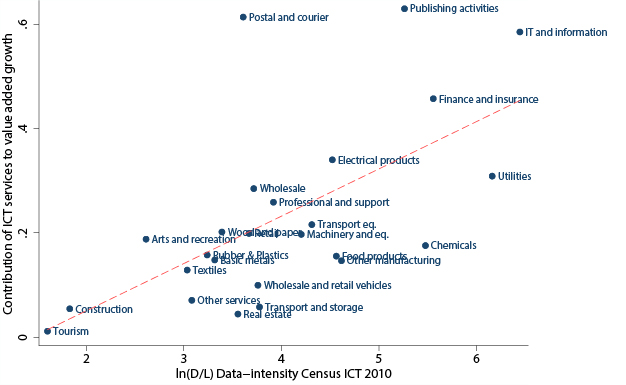
One long-standing concern in the economic field has been that services contribute little to economic development. Services would suffer from a so-called Baumol’s cost disease (Baumol 1967), meaning factors such as labor cannot be easily substituted for more productive factors using existing technologies, as it happens in manufacturing. Over time, this would lead services to become a drag on the economy relative to other more productive industries.
Services and internet technology
In an era of the internet and many advanced forms of digital and information and communication technology (ICT), that notion of services appears to have become increasingly out of date. Already, services traded online make up more than a quarter of global trade—and this share is ever growing. Moreover, services such as in information and information technology (IT), communications, and finance have demonstrated high productivity levels (IMF 2018) as well as being digital-intensive.
Over the years, the productivity levels of some of these digital-intensive services have been positive, albeit not always in line with manufacturing productivity. New types of ICT, platforms, and cloud computing are just a few examples that have helped some previous stagnant services become more tradable and productive, thereby showing some pro-development features. In fact, services that make more use of these new digital technologies often are real contributors to economic growth.
The figure below shows on the horizontal axis an indicator that measures the extent to which sectors are using the internet as well as internet technologies and software: what we call “data intensity.” Not surprisingly, the IT and information services sector, which has caught up with manufacturing, uses digital technologies extremely intensively, as do finance and publishing services.
Data intensity using software over labor (D/L) and contribution to value added

ICT = information and communication technology, IT = information technology.
Source: Author’s calculations using United States Census, Bureau of Labor Statistics, and EU KLEMS data.
The vertical axis plots a second indicator and measures the contribution of ICT services to value-added growth. More specifically, it shows how well sectors are able to make use of ICT as instrumental in adding value to an average Organisation for Economic Co-operation and Development (OECD) economy. The figure clearly shows a strong increasing trend; the more services use internet technologies, the more they contribute to economic development by creating greater levels of value added.
However, whether the contribution of digital-intensive value added in services truly translates into optimal allocation of technology resources is another question. Policies can determine to a large extent whether technology is effectively used across sectors. If applied suboptimally, the contribution of ICT services may in fact generate value-added growth but not much productivity growth. More generally, this would mean that misallocation occurs, which in this case is the way technology is (under)used.
Policies on the cross-border flow of data
To a great extent, that is what is happening. Countries have started to regulate, for instance, how companies should employ data, how industries should compete with online platforms, or how sectors should use cloud computing technologies. Some of these regulatory policies aim to solve market failures such as the right to privacy when companies work with personal data. Other policies, however, have an unnecessarily distortive effect rather than achieving a noneconomic objective.
For instance, data localization can be considered a distortive policy. It mandates a company to keep data inside a country’s territory, to process and work with the data locally, and/or to store the data locally. In addition, some countries apply other domestic regulatory rules that make it burdensome to work with data, such as the requirement to hire a data processing officer, which particularly for small and medium-sized enterprises (SMEs) can be costly.
Distortive policies that aim at restricting internet technologies have a negative impact on productivity, as shown in Ferracane, Kren, and van der Marel (2018). That, in turn, prevents countries from translating value added resulting from ICT used in services into productivity generated without misallocation of (internet) technologies. Policies related to the domestic use of data in particular, such as requirements for data processing officers for SMEs or strict data retention, tend to restrict productivity in digital-intensive services.
Conclusion
In short, inhibiting the movement and use of data with unnecessarily restrictive policies is likely to delay any solution to the Baumol’s cost disease of low productivity that we see in various services. In addition, some studies (e.g., van Ark 2016) find that ICT such as data services still need to be further “infused” in many other sectors before witnessing large productivity payoffs. Distortive policies frustrate prospective economic developments of embedding ICT into the wider economy.
While it is obvious that certain measures are necessary to protect the privacy of citizens and national security, the economic impact of restrictive policy restrictions on data and other internet technologies should be carefully weighed in order to strike the right balance between different important policy priorities, without excessively increasing costs for firms and, eventually, consumers.
_____
References:
Baumol, W.J. 1967. Macroeconomics of Unbalanced Growth: The Anatomy of Urban Crises. American Economic Review 57(3): 415–26.
Ferracane, M.F., J. Kren, and E. van der Marel. 2018. Do Data Policy Restrictions Impact the Productivity Performance of Firms and Industries? ECIPE DTE Working Paper Series No. 1. Brussels: European Centre for International Political Economy.
International Monetary Fund (IMF). 2018. Manufacturing Jobs: Implications for Productivity and Inequality. IMF World Economic Outlook Report April 2018. Washington, DC: IMF.
van Ark, B. 2016. The Productivity Paradox of the New Digital Economy. International Productivity Monitor 31(Fall): 3–18. Ottawa, Canada: Centre for the Study of Living Standards.







Comments are closed.